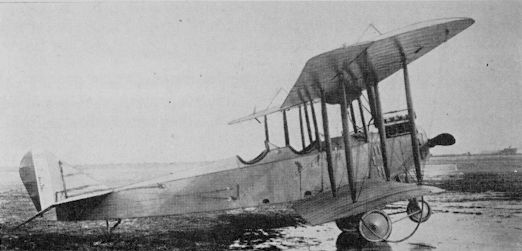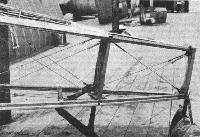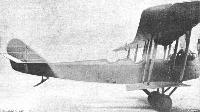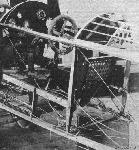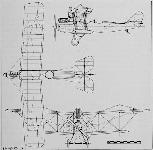G.Swanborough, P.Bowers United States Military Aircraft Since 1909 (Putnam)
The Standard J Series
The Standard SJ of 1916 was a direct development of the earlier Sloan biplanes and the Standard H series, all designed by Charles Healey Day. Upon American entry into World War I, the Standard SJ was ordered in quantity as a primary trainer to supplement Curtiss JN-4 production. There was little difference between the two designs, the Standard being recognizable mainly by swept-back wings, somewhat wider gap, and a 4-cylinder Hall-Scott A-7 engine with a narrow vertical radiator mounted on top of the fuselage and ahead of the upper wing. The SJ had a small auxiliary wheel ahead of the main wheels to help prevent noseover in soft ground or bouncy student landings.
While the SJ was entering production, Standard introduced a revised and beefed-up model JR, a two-seater with a 175 h.p. 6-cylinder Hall-Scott A-5 that the company optimistically named the “Pursuit”. This machine was entirely unsuited to European military operations and the Army bought only six as advanced trainers. Certain features of the JR were incorporated into the major production version of the SJ, which became known as the J-1. Principal differences from the previous models were deletion of the nose-over wheel and a change from the Deperdussin wheel control system to the more popular stick. The main drawback to the J-1 was the Hall-Scott A-7 engine, which was extremely troublesome and frequently caught fire in the air. Because of this, service use of the Standards diminished as adequate numbers of JN-4s became available. Standard revised the JR-1 in 1918, and produced a new advanced trainer model, the JR-1B, with 150 h.p. Wright-Hispano, nose radiator, equal span wings with lower wing below the fuselage, and new tail surfaces, but the Army bought only six (42111/42116). When the Army started to fly the airmail in May 1918 these were converted to single-seat mailplanes. A further variant was the E-4, identical to the JR-1B except for a longer upper wing.
TECHNICAL DATA (J-1)
MANUFACTURER: Standard Aircraft Corporation, Plainfield, New Jersey.
TYPE: Trainer.
ACCOMMODATION: Pupil and instructor in tandem open cockpit.
POWER PLANT: One 90 h.p. Curtiss OX-5 piston in-line (or 150 h.p. Wright-Hispano A).
DIMENSIONS: Span, 43 ft. 10 in. Length, 26 ft. 7 in. Height, 10 ft. 10 in. Wing area, 429 sq. ft.
WEIGHTS: Empty, 1,557 lb. (1,660 lb.). Gross, 2,070 lb. (2,206 lb.). PERFORMANCE: Max. speed, 69-5 m.p.h. (85 m.p.h.). Initial climb, 70 ft./min. (590 ft./min.). Service ceiling, 5,800 ft. (15,000 ft.).
ARMAMENT: None.
KNOWN SERIAL NUMBERS:
SJ, J-1: 193/208; 960-1056; 1660/2403; 4477/4994; 22403/22803; 41208/41357.
JR-1B: 42111/42116.
Jane's All The World Aircraft 1919
THE STANDARD MODEL "J-R" MILITARY TRAINING TRACTOR, WITH HALL-SCOTT 175-H.P. MOTOR.
The Standard Model "J-R" is one of America's recent productions in the way of an advanced training machine. It is similar in general form to the Standard Model" J " Military Preliminary Training Tractor. The 90-h.p. motor has been replaced by a special Hall-Scott 175-h.p. motor, and the R.A.F. No. 3 wing curve has been superseded by the U.S.A. No. 6.
Home leading features of the " J-R " model are as follows :
(1.) The two-wheeled steel landing gear combines lightness with strength and is perfectly streamlined throughout so as to offer a minimum of head resistance. On landing, the axle rises in vertical guides, and when normal rests in a U-shaped steel case streamlined with aluminium.
(2.) All wing struts are provided with ball and socket fittings.
(3.) An auxiliary fan, driving the gear fuel-pump, projects out from the fuselage, and pumps the fuel from the main tank to the gravity tank.
(4.) The engine-bed is made very rigid by means of stool tube stays which connect the ash engine supports to the longerons.
(5.) There is a single control of the Dep. type in the rear cockpit.
(6.) The radiator is mounted over the motor and is free from vibrations. It strikes one, however, that it produces immense head-resistance.
(7.) There is a single complete manifold for the exhaust.
(8.) The exhaust pipe leads the gases over the top plane.
(9.) Throughout the entire machine, the weight has been kept down and yet none of the strength or air-worthiness has been impaired.
GENERAL SPECIFICATIONS.
General Dimensions.
Wing span, upper plane 42 ft. 10 in.
Wing span, lower plane 31 ft.
Wing chord 6 ft.
Gap between wings 71 in.
Stagger 10 degs.
Overall length of machine 27 ft. 2 1/2 in.
Overall height of machine 10 ft. 10 in.
Angle of incidence 2 1/2 degs.
Dihedral angle 3 per cent.
Sweepback 5 degs.
Wing curve U.S.A. No. 6.
Tail plane, angle of incidence 0 deg.
Areas.
Upper wing 258 sq. ft.
Lower wing 159 sq. ft.
Total supporting surface
(wings and ailerons) 417 sq. ft.
Ailerons (each 21 sq. ft.) 42.
Tail plane 23.7 sq. ft.
Fin, vertical 3.7 sq. ft.
Elevators (each 11 sq. ft.) 22.
Rudder 10 sq. ft.
Max. load per sq. ft. supporting surface 5.75 lbs.
Max. load per h.p. 13.7 lbs.
Weight.
Net weight, machine empty 1,764 lbs.
Gross weight, machine loaded 2,400 lbs.
Performance.
Max. speed, full load 95 m.p.h.
Min. speed, full load 48 m.p.h.
Gliding angle 1 to 11.
Climbing speed in 10 minutes 5,000 ft.
Power Plant.
Hall-Scott A-5A special, 6-cyl vert, four-stroke cyl. water-cooled.
Horse-power (rated at 1,400 r.p.m.) 175 h.p.
Weight 605 lbs.
Bore on stroke 5 1/2 in. by 7 in.
Fuel consumption per hour 14 gals.
Fuel tank capacity 51 gals.
Gravity tank capacity 7 3/4 gals.
Total tank capacity 58 3/4 gals.
Oil capacity in crank-case 4 gals.
Propeller.
Make "Standard."
Material Black walnut.
Diameter 8 ft. 4 in.
Pitch 5 ft. 6 in.
Direction of rotation
(viewed from pilot's seat) Clockwise.
Landing Gear.
Number of wheels 2
Size of wheels 26 in. by 4 in.
Thread 68 3/4 in.
As may be seen from the firm's own figures for performances. the machine cannot be used for war purposes, as the maximum speed would have to be increased by 25 per cent, and the climb by 100 per cent, before it would be safe to send over the lines at all in 1918. Nevertheless, in the advanced stages of training, after a pupil has left the slow preliminary types, and before putting him onto war aeroplanes, the machine should find a distinct field of usefulness.
THE STANDARD J.R.1 BIPLANE.
(Built by the Standard Aircraft Corporation.)
Specification.
Type of machine Single-seater Biplane.
Name or type No. of machine J. R. 1.
Span 31 ft. 4 3/4 In.
Overall length 26 ft. 2 in.
Maximum height 10 ft. 10 3/16 In.
Engine type and h.p. 170 h.p. Hispano-Suiza
engine. Weight of machine empty 1,566 lbs.
Petrol tank capacity In gallons 60 gallons.
Performance.
Speed low down 100 m.p.h.
Landing speed 48 m.p.h.
Climb.
To 5,300 feet in minutes 10 mins.
Total weight of machine loaded 2,400 lbs.
P.Bowers Curtiss Aircraft 1907-1947 (Putnam)
Rebuilt Standard
Among the surplus aeroplanes that Curtiss bought from the US Government in 1919 were numerous model J-1s designed by the Standard Aero Corporation. These were also built under licence by the Fisher Body Division of General Motors, Wright-Martin, and Dayton-Wright. Since one of the major deficiencies of this model was the original 100 hp Hall-Scott A-7A engine, Curtiss reconditioned the J-1s to nearly-new and sold them for $3,500, approximately half the cost of a new machine. Wing area varied depending on whether the original ailerons or larger ones built by Curtiss to improve controllability were fitted.
OX-5 powered version
Trainer. Two pilots. 90 hp Curtiss OX-5.
Span 44 ft 10 21.32 in (13.68 m); length 27 ft 1 1/2 in (8.26 m): height 10 ft 4 5/8 in (3. 16m): wing area 429 sq ft (39.85 sq m).
Empty weight 1.448 lb (657 kg): gross weight 2,025 lb (918 kg).
Maximum speed 68 mph (109.43 km/h); cruising speed 54 mph (86.9 km h): climb 410 ft/min (2.08 m/sec): service ceiling 9.250 ft (2.819 m); range 344 miles (553 km).
C-6 powered version
Trainer. Two pilots. 150 hp Curtiss C-6.
Span, length and height as OX-5 version. Wing area (with large ailerons) 436 sq ft (40.5 sq m). Empty weight 1.500 lb (680 kg): gross weight 2.275 lb (1,032 kg).
Maximum speed 79.3 mph (127.61 km/h); cruising speed 63.4 mph (102.03 km/h); climb 710 ft/min (3.60 m/sec); service ceiling 9.750 ft (2.972 m): range 264 miles (425 km).
Журнал Flight
Flight, October 18, 1917.
TWO STANDARD TRACTOR BIPLANES.
Since our description of the Standard H-3 tractor biplane, which appeared in "FLIGHT" for May 24th last, two other models have been turned out by the Standard Aero Corporation of New Jersey, U.S.A., viz., the "J" preliminary training tractor and the J-R reconnaissance type. Both are from the designs of Chas. H. Day, and follow more or less closely previous Standard practice. The model J has given very satisfactory results as a training machine, and is now, it is stated, being manufactured in quantity. The special feature of this machine is its low landing speed - 37 m.p.h. This, together with the three-wheeled landing chassis, makes it a comparatively safe and easy machine for beginners to practice landings - always the bugbear of the embryo pilot. Strength, another valuable asset in a training machine, has also received the attention of the designer, a factor of safety of 7.5 being employed throughout the machine.
A certain amount of natural lateral stability is obtained by giving the wings a back-sweep of 5, whilst the low wing loading of 4.5 lbs. per square foot and the employment of the R.A.F.3 wing section make for good climb and the low speed. Unlike the H-3, the top plane, which alone carries the ailerons, overhangs the lower plane by 6 ft. each side. It is also staggered forward about 1 ft. Attachment of the top plane is made to a small central panel, of the same width as the fuselage, supported above the latter by four struts. The overhung is braced from a cabane mounted above the outer pair of interplane struts. The two sections of the lower plane are attached direct to the fuselage. The wing and other fittings, as on the H-3, are noteworthy for their elaborate character, necessitating intricate brazing. The pantograph type rubber shock-absorbing device is fitted to the landing gear as before ; the main wheels measure 26 ins. by 4 ins., and the front wheel is 20 ins. by 4 ins. The control is of the dual, interchangeable Dep.-Curtiss type. The engine is a 90-100 h.p. four-cylinder vertical Hall-Scott "A-7," coupled direct to a Standard black walnut tractor screw. The radiator, which is long and narrow, is mounted above the engine. Except for detail improvements, the model J is otherwise similar constructionally to the H-3, so the following characteristics, together with the accompanying illustrations and scale drawing, should suffice :-
Span, (top) 44 ft., (bottom) 32 ft.; chord, 6 ft.; gap5 ft. 11 ins.; sweep-back, 5°; dihedral angle, 3 per cent.; wing section, R.A.F.3; angle of incidence, 2 1/2°; overall length, 26 ft. 7 ins.; area of top plane, 264 sq. ft.; bottom plane, 165 sq. ft.; total supporting surface (including ailerons), 429 sq. ft.; area of ailerons, 42 sq. ft.; loading, 4.5 lbs. per square foot; weight, empty, 1,350 lbs.; useful load, 600 lbs.; speed range, 37-68 m.p.h.; climb, 2,600 ft. in 10 minutes ; gliding angle, 1 in 8.
The Standard model J-R is similar in general form to the model J. It has, in fact, been evolved from experiments made with, and data obtained from, this latter machine. Instead of a 90 h.p. engine, one of 175 h.p. - the 6-cyl. Hall-Scott model A-5A - has been installed, whilst the wing section is the U.S.A.6. These two modifications, together with a reduction in wing area, give a maximum speed of 95 m.p.h. and a climb of 5,000 ft. in 10 minutes. The span of the top and bottom planes is 42 ft. 10 ins. and 31 ft. respectively, the chord, gap, stagger, sweep-back, dihedral and angle of incidence are the same as on the model J. The central panel of the top plane is, as before, the same width as the fuselage, 2 ft. 6 ins. A space of 1 1/2 ins. is left between the panel and the wing sections, as is also between the fuselage and the lower wings. Among the special features of the J-R are the following: In the two-wheeled steel landing gear, which combines lightness with strength and is well streamlined, the axle rises and falls in vertical guides, and when normal rests in U-shaped steel cases stream-lined with aluminium. All the interplane struts are provided with ball and socket fittings, giving an even bearing for any angle of the struts. The engine bed is extremely rigid, being braced by means of steel tube stays connecting the ash bearers to the fuselage longerons. The exhaust is led over the top plane by means of a single complete manifold from the exhaust ports, after the fashion obtaining in the majority of German machines. An auxiliary fan-driven gear pump, projecting out from the fuselage, pumps fuel from the main tank of 51 gallons capacity, to the gravity tank, of 7 3/4 gallons capacity, which is mounted on the underside of the central top plane panel.
The fuselage is 24 ft. 3 ins. in length, the maximum width is 2 ft. 6 ins., and the maximum depth, at the forward cockpit, is 3 ft. 4 ins. The rounded nose-piece at the forward end of the engine is made detachable. The upper longerons are horizontal to the line of flight, whilst the lower ones follow a continuous curve from nose to tail. Sheet metal is employed for the covering of the engine housing and the top turtle deck as far back as the rear or pilot's cockpit. The remainder of the fuselage is fabric covered. Single Dep. control is installed. The stabilising tail plane is horizontal to the line of flight, and is supported by a pair of bracing wires above and below at each side of the fuselage.
The Hall-Scott A-5A is a six-cylinder vertical water-cooled engine developing 175 h.p. at 1,400 r.p.m. It has a bore and stroke of 5 1/4 ins. and 7 ins. respectively. It weighs 605 lbs., and has a fuel consumption of 14 galls, per hour.
The following are the main characteristics of the J-R: Span, (top) 42 ft. 10 ins., (bottom) 31 ft.; chord, 6 ft.; gap, 5 ft. 11 ins.; stagger, 10°; sweep-back, 5°; dihedral angle 3 per cent.; wing section, U.S.A.6; angle of incidence, 2 1/2°; overall length, 27 ft. 2 ins.; area of top plane, 258 sq. ft.; bottom plane, 159 sq. ft.; total supporting surface (including ailerons), 417 sq. ft.; area of ailerons, 42 sq. ft.; loading, 5.75 lbs. per square foot; weight, empty, 1,764 lbs.; useful load, 636 lbs.; speed range, 48-95 m.p.h.; climb, 5,000 in 10 minutes; gliding angle, 1 in 11.

